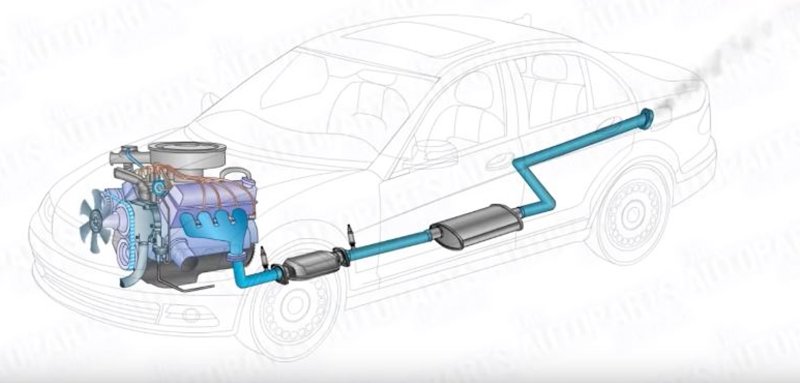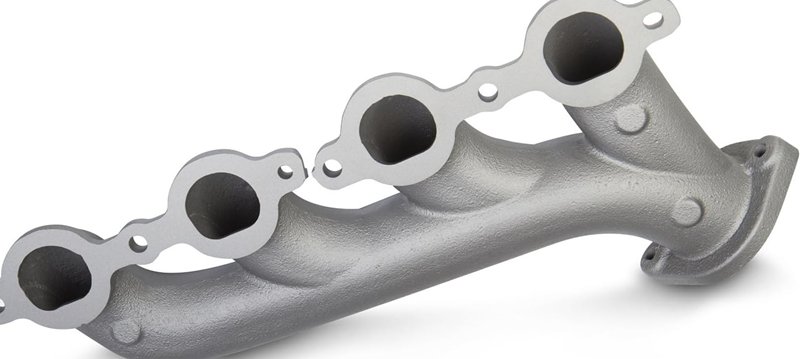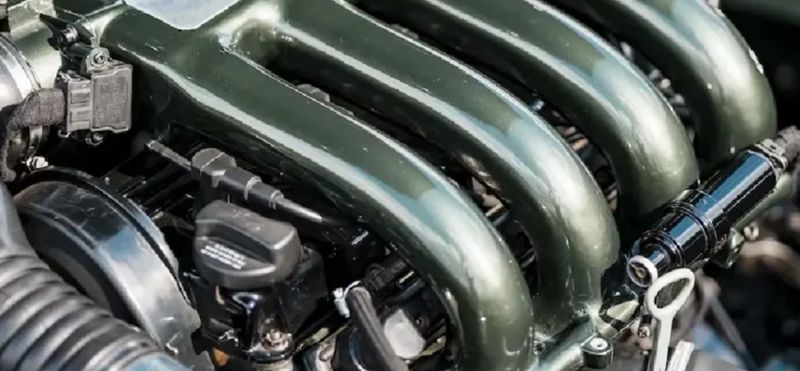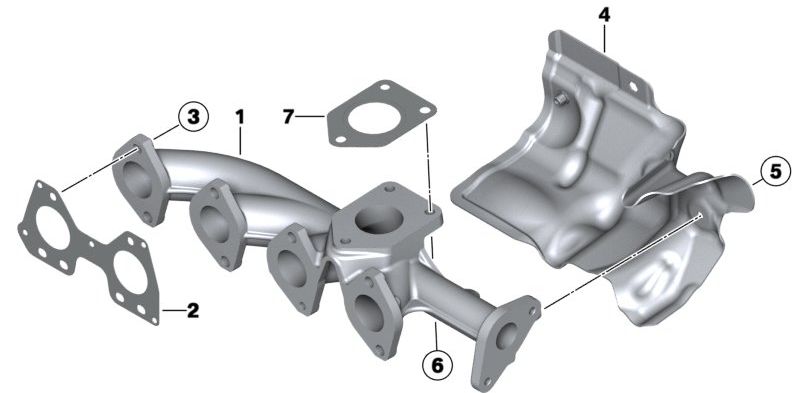Under the hood of every car lies a complex structure – the car manifold – directly connected to the vehicle’s engine through a couple of pipes and tubes. Beyond playing a crucial role in expelling exhaust gasses, the manifold optimizes the car’s efficiency and performance.
This article discusses what is car exhaust manifold, including how it works. We also include critical information on the manufacturing processes and custom design options for creating it.
What is a Car Exhaust Manifold?
The car exhaust manifold is an integral component of the engine system that plays a vital role in ensuring the efficient functioning of the engine. Its main function is to collect exhaust gasses after combustion in the engine cylinders and direct them to the exhaust pipe. The system consists of pipes and tubes linking the internal combustion chamber with the exhaust system.
Many often refer to the exhaust manifold as just the manifold. However, we must inform you that a typical automotive system consists of the intake and exhaust manifold.
Intake and Exhaust Manifold
While the intake manifold is responsible for distributing fuel-air mixture into the internal cylinders for combustion, the exhaust manifold takes the by-product of the combustion – the gasses away. Therefore, it is important you do not mistake each component.
Besides acting as a channel and passage for exhaust gasses from the combustion chamber into the exhaust tubes, the exhaust manifold also helps improve engine output fuel efficiency and enhance overall car performance.
 How Does an Exhaust Manifold Work?
How Does an Exhaust Manifold Work?
We mentioned earlier that the main function of the exhaust manifold is to collect gasses from the internal combustion engine and pass them to the exhaust pipes. This seems pretty straightforward; however, the operation occurs in four main steps, which we’ll discuss below.
Step 1: Exhaust Gas Collection
As mentioned above, the exhaust manifold links directly to the engine cylinder, where combustion occurs as fuel and air mixes as the engine runs. As this happens, the exhaust valves in the cylinder open, allowing the expulsion of the product of said combustion – high temperature and pressurized exhaust gasses – into the exhaust system.
Step 2: Merging and Channeling
These two processes are critical roles of the exhaust manifold. The number of pipes that connect your car’s internal combustion engine to the exhaust manifold depends on the number of cylinders in your car. That said, the manifold ensures the merging of each pipe into a single outlet for effective combination before channeling it into another tube – the collector. Combining the merging and channeling process equalizes the flow of the exhaust fumes.
Step 3: Backpressure Optimization
Another function of the exhaust manifold is to optimize the backpressure. The gases leaving the cylinders may experience some sort of resistance – backpressure. The exhaust manifold helps to reduce this pressure and promotes easy passage out of the cylinders. This action helps allow a consistent flow of these gasses out of the internal combustion chamber for better power generation and overall car efficiency.
Step 4: Tuning
Tuning helps enhance the efficiency of your vehicle. However, this role of the exhaust manifold does not apply to all vehicles. It is specific for manifolds having the “tuned length design.” Such cars have the lengths of their exhaust manifolds tuned (optimized) for improved engine performance. This action helps enhance the car’s revving, power, and torque output.
Different Materials for Fabricating Car Manifolds
Different materials are suitable for fabricating car manifolds. Each material has its benefits over the other towards enhancing the vehicle’s functionality.
Below are the standard materials for creating car manifolds.
Cast Iron
Cast iron is one of the most used materials for manufacturing exhaust manifolds. It has been in use for a long time because of its ability to withstand harsh conditions, including high resistance to heat and corrosion, making it highly durable.
However, the main shortcoming of cast iron is its weight; it is heavy, especially compared to other materials like aluminum. The high density also makes the customization of manifolds with this material challenging. However, because of its cost-effectiveness, it remains the go-to material for mass fabrication of exhaust systems of passenger vehicles.
 Aluminum
Aluminum
Aluminum is the go-to material for automotive parts manufacturing. Its unique properties, such as its incredible strength-to-weight ratio and corrosion resistance, significantly benefit the automotive sector. For example, its low density makes it a critical material of choice for reducing the weight of automobiles.
Compared to other materials like iron and steel, aluminum is less durable. However, the automotive industry cherishes weight reduction, which is critical for optimizing engine performance and achieving higher torque and speed for race cars. In addition, aluminum is an excellent conductor of heat.
Stainless Steel
Stainless steel is also one of the most used materials for manufacturing purposes. It possesses superior characteristics to several materials, including considerable strength, easy formability corrosion, and resistance and durability.
However, it is relatively more expensive but still offers a suitable balance between cost and performance. Like aluminum, stainless steel is easy to machine and work with, making it a practical choice for custom exhaust manifold fabrications. Also, it is a highly durable material, ensuring it creates long-lasting exhaust manifolds.
Carbon Steel
Carbon steel is more or less a fine balance between cast iron and stainless steel. Therefore, it possesses all suitable properties for manufacturing exhaust manifolds. It is relatively resistant to heat and corrosion and has a high tensile strength. Also, it is highly durable and cost-effective. All these features make it a popular choice in fabricating car exhaust manifolds.
Manufacturing Techniques for Custom Exhaust Manifold Components
Here, we’ll discuss the various manufacturing methods employed in custom car manifold fabrication.
Die Casting
Die casting is the typical method for manufacturing exhaust manifolds, especially for bulk volume production. The casting process involves heating the metal, such as cast iron or aluminum, into molten form before pouring it into a pre-made mold. In the mold cavity, the liquified metal cools and solidifies into the desired shape under high pressure.
Afterward, the fabricated structure, such as an exhaust manifold, can undergo further processes, such as CNC machining, to enhance the final product. The process is pretty suitable for manufacturing automotive manifolds because of its ability to create intricate designs with high precision and tight tolerance.
Also, it is a highly efficient and versatile process. Automotive die casting can create strong and lightweight structures, making it suitable for manufacturing exhaust manifolds for high-performance vehicles.
 CNC Machining
CNC Machining
Indeed, CNC machining is one of the common techniques for various manufacturing purposes in the automotive industry, a typical example being cylinder head machining. However, when it comes to manufacturing exhaust manifolds, it is more or less a secondary process used after casting.
While die casting is highly versatile, it isn’t as precise as CNC machining. Therefore, manufacturers use the CNC machining’s precision properties to enhance the shape and finish the casted manifold. This includes shaping, drilling, and milling the exhaust manifold to ensure it reaches the desired tolerance and specifications, especially for custom fabrication.
3D Printing
While 3D Printing is a highly versatile process for various manufacturing purposes, including for automotive parts, its use in automotive metal fabrication is limited. This is mainly because of the high costs. Also, most materials suitable for 3D Printing, like ABS and PLA, don’t have the mechanical properties that support the harsh conditions exhaust manifolds experience.
However, 3D Printing still benefits rapid prototyping of these components, especially for custom parts, and may be used to create intricate features in the casting molds. In this case, it allows for rapid and precise development of the manifold to test the design before switching to more suitable manufacturing techniques.
 Surface Treatments on Exhaust Manifold Parts
Surface Treatments on Exhaust Manifold Parts
Surface treatment involves a series of post-production processes to enhance the appearance and performance of an already manufactured part, especially for customization. After casting the exhaust manifold and carrying out any secondary processes like machining, you can proceed to surface treatment to improve the aesthetics and functionality.
Below are three common surface treatments for exhaust manifolds.
Passivation
Passivation is a chemical process that helps rid surface contaminants and blemishes, enhancing corrosion resistance. Generally, exhaust manifolds are exposed to high temperatures and corrosive gases, consequently requiring passivation. The process helps create a protective film on the surface of the manifold, shielding it from the corrosive gases, thereby enhancing its lifespan.
Polishing
Like passivation, polishing is a surface finishing process that helps increase the appearance of a material. It is particularly important for custom part fabrication of automotive parts, as it helps create a reflective and shiny surface.
However, unlike passivation, it is a mechanical process and focuses on improving appearance, with little to no effect on the chemical properties of the material. However, since it helps smoothen the exhaust manifold, it may benefit the easy flow of the gasses, reducing resistance and enhancing the car’s performance.
Anodizing
Anodizing is an electrochemical process that involves creating a protective anodic oxide film around a material (mainly aluminum) to improve its corrosion resistance and appearance. It is a common surface treatment in the automotive industry, as it extends the durability of parts, such as car exhaust manifolds.
Customization and Design Considerations for Car Exhaust Manifold
Custom exhaust manifolds are often designed for specific performances and aesthetic appeal. Many custom enthusiasts customize their car exhaust manifolds to improve aesthetics, reduce emissions, and optimize engine performance.
Generally, the following are the go-to custom design choices for exhaust manifolds, including how they impact the vehicle’s performance.
Tuned Lengths
Tuned length refers to the actual length of the manifold piping. However, in this case, machinists carefully calculate the length to create resonance in the exhaust system to attain higher RPMs. Therefore, automobiles with tuned-length exhaust manifolds experience enhanced torque and power at higher RPM ranges. It helps to improve the car’s sensitivity and maximize the engine efficiency.
 Precision Milling and Port Machining
Precision Milling and Port Machining
High-precision Milling of exhaust manifold ports helps to optimize the shape and size of these ports, ensuring they are a perfect fit for the engine’s cylinder heads. Also, port machining helps to enhance exhaust, minimizing the resistance and significantly enhancing the engine’s overall performance. Therefore, regardless of the engine’s complexity and specifications, CNC machining allows you to customize port designs that perfectly suit the engine, maximizing optimal airflow and power generation.
Equal Length vs. Unequal Length
In a customized exhaust manifold, the length of each pipe and tubing (runners) linking the engine cylinder to the manifold can be designed to be equal or unequal. Whether the lengths of the runners are equal or not benefits the car’s performance. It just depends on your engine characteristics and the goal of customization.
For example, equal length indicates that the exhaust gasses from each cylinder arrive at the collector simultaneously. It minimizes interference and optimizes performance since the gasses are quickly channeled into the exhaust pipes. However, in unequal-length runners, the tubings have varying lengths, allowing the car to reach higher RPM bands. Indeed, scavenging the exhaust gasses is not as straightforward as in equal lengths, they may be tailored for specific goals.
Applications of Car Manifolds
As mentioned, the car exhaust manifold plays a crucial role in the automobile engine’s functionality and performance. Below is a brief overview of its applications.
- Emission Control: Its main function is to direct exhaust fumes from the internal cylinders to the vehicle’s exhaust system. This helps to reduce harmful emissions into the environment.
- Enhance Engine Performance: Optimizing the outflow of these unburnt gases ensures increased power and torque, including fuel efficiency of the vehicle. All of these result in increased performance.
- Heat Control: High-performance and racing cars require robust exhaust manifolds with advanced heat dissipation. Custom manifolds help improve heat dissipation, which is crucial for maintaining the durability of the engines of such vehicles.
Partner With AutoProtoWay for Your Custom Car Manifold Manufacturing
Custom exhaust manifold fabrication requires expertise. Therefore, you should partner with an expert manufacturer to help make your car manifold to your desired specifications.
At AutoProtoWay, we offer custom services in various manufacturing processes, including CNC machining, die casting, sheet metal fabrication, and 3D printing. Whether you need automotive prototypes or parts, we can provide one-stop machining and surface treatment services for you. Just upload your CAD files to get a quote today!
Conclusion
Regarding customization of car parts, the exhaust manifold is a critical component for enhancing the vehicle’s performance. While there are different material choices for fabricating this component, selecting the right material is crucial for achieving specific custom goals.
While cast iron guarantees durability, aluminum for weight reduction, carbon steel is the economical choice, and stainless steel for superior corrosion resistance. In addition, we also discussed the manufacturing processes for this versatile component, including custom design options to enhance its functionality further.
FAQs
Do custom car manifolds really affect car performance?
Yes, custom car manifolds help enhance the car’s performance. Optimizing the lengths and collector designs allows the car to attain higher RPMs and increase the car’s torque and power output when driving. However, note that the increased performance and functionality of the car are more noticeable in high-end and racing vehicles.
Where is the manifold in a car?
The manifold is usually beneath the car’s hood. You find it connected to the engine’s cylinder through a series of pipes that help convey the exhaust gases.
How do you know if a car manifold is defective?
Typical signs of a defective car manifold include engine misfiring, increased noise, engine idling, poor fuel economy, and reduced power generation. Upon visual inspection of the pipes and tubes, you would probably notice cracks or leaks confirming issues with the manifold.




